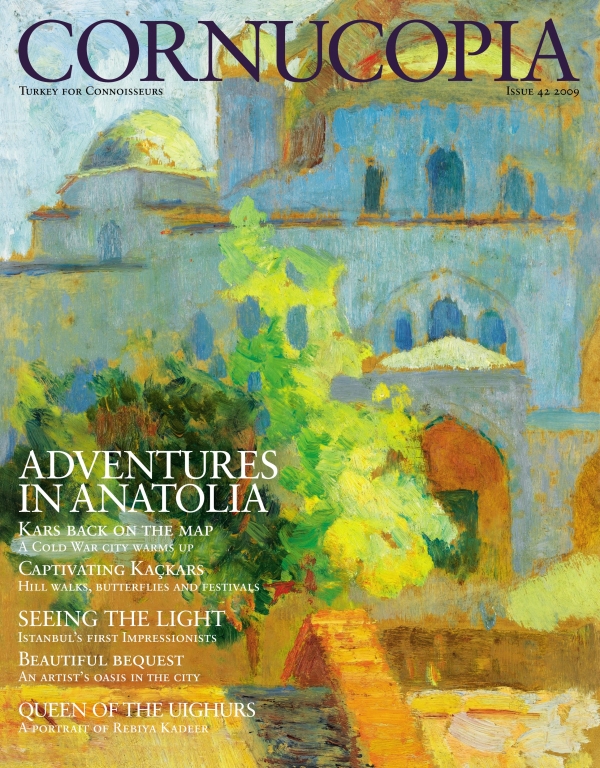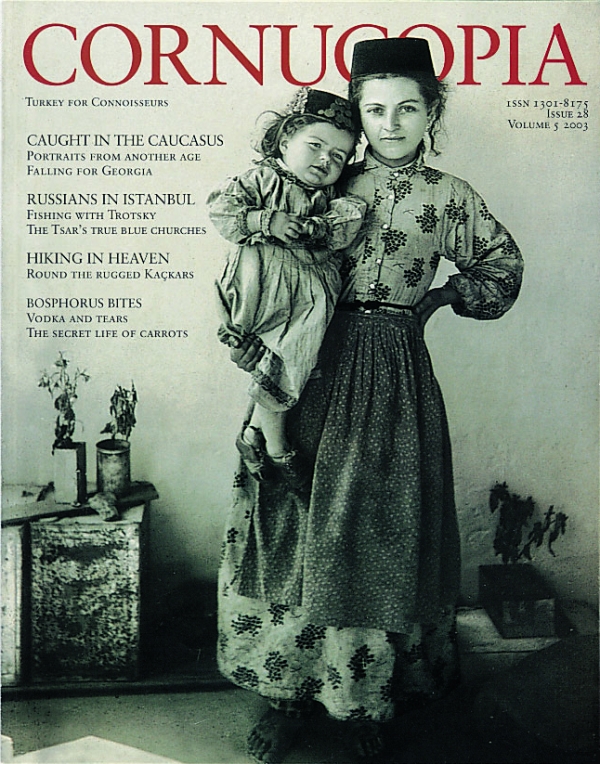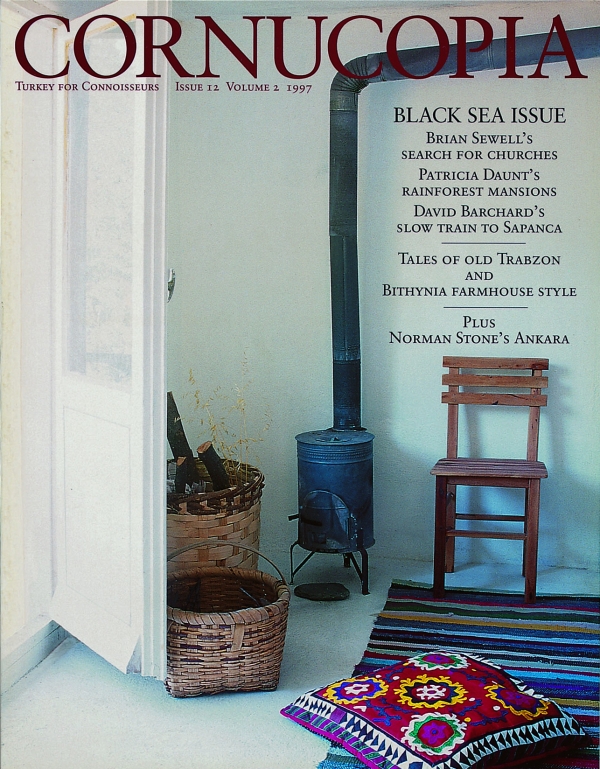Buy or gift a stand-alone digital subscription and get unlimited access to dozens of back issues for just £18.99 / $18.99 a year.
Please register at www.exacteditions.com/digital/cornucopia with your subscriber account number or contact subscriptions@cornucopia.net
Buy a digital subscription Go to the Digital EditionMichael Meeker sets out to decipher the architecture of a forgotten Black Sea stronghold
With its bay sparkling hundreds of metres below, the vista from above the town of Sürmene, forty kilometres east of Trabzon, is one of the most stunningly beautiful along the eastern Black Sea coast. I had set out on a tour of these mountains with, as my guide, a passionate amateur historian who has devoted his life to a study of the area.
“This is the very spot where Xenophon is said to have first observed the sea as he led his army out of Persia,” Mr Asian announced as we reached one of the hilltops that seem to hang over the bay. Was this true? Who could say? Certainly the spot deserved its reputation by virtue of its breathtaking panorama.
Thanks to the network of roads that first began to link mountain villages in the 1950s and 1960s, we were able to make the trip by car. It was a thrilling drive. Here and there we lurched forward, wheels spinning out of control as we climbed the vertiginous slopes. I was treated to a series of fascinating scenes. Stopping at a roadside forest, Mr Asian led the way through the undergrowth, then tore away the brush to reveal tombstones bearing dates from the late Ottoman period. Each was topped by a stone-carved emblem indicating the sex of the deceased and, if male, his status as a cleric or government official. Higher up, perched on mountain bluffs, were the walled graveyards of distinguished families, some of recent construction, some Ottoman.
At one stage of our winding journey Mr Aslan pointed out a secret route through the foothills, used by Russian troops for their invasion of the coastal districts in 1916. Most foreign observers claim that the coastline provides the only convenient way to travel east and west. Neither the Turkish nor the Russian military were ever troubled by such a misperception.
In many places our road intersected or paralleled the course of older trade routes: dirt or cobbled tracks crossed by wooden or stone bridges of medieval origin. Higher still, we could observe the principal trade route that has linked the coastline with the interior for many hundreds of years, snaking across the ridges of vivid green but treeless mountains, sometimes disappearing in the clouds that hang in the valleys. Here and there along its way, small clusters of storerooms and warehouseswere visible, little mini-caravansarays of wood and stone, some still in use.
As an historically minded anthropologist, my special interest lay less with Xenophon than in the area’s variety of family life and housing. How, I wondered, had these been influenced by the broad historical changes the Black Sea coastal region had undergone over the centuries?
Surely, I had originally thought when I went to live in the area, language and religion must determine styles of family life and house structure. In the district called Of, for example, I had learnt that many of the tools and methods of construction could be traced to practices of the Greek rather than the Turkic population, and that the hearths of Christian houses were situated differently from those in Muslim houses.
Eventually I realised it was not that simple, that ethnicity and religion had been fluid rather than fixed. The region had been settled at different times by a number of ethnic groups – Lazi, Armenians, Greeks and Turks – who had lived under a succession of imperial regimes espousing different religions. But no group had preserved a pure “ethnic” tradition. For example, there were Christian Turks in the region during both the late Byzantine and early Ottoman periods, some of whom probably became Greek-speakers. And in the twentieth century there were Muslim Greeks, Muslim Lazi and Muslim Armenians, many of whom had become Turkish-speakers.
Such crossovers persuaded me to alter the focus of my research. I began to consider the issue of how an ethnically and religiously diverse population had been ottomanised in the seventeenth and eighteenth centuries. I set aside the question of discovering the “original” or “primordial” way of life in the region to focus instead on change and variety in the patterns of family life and house structure.
As we toured the foothills and mountains of Sürmene, Mr Aslan showed me dwellings, maize granaries, pilgrim fountains and walled gardens in a remarkable range of types and styles that opened my eyes to the complexity of official and domestic architecture.
It is important to understand the relationship of Sürmene to Trabzon. From the medieval period, Trabzon was a walled and fortified town that served as the capital of all the coastal districts from Batum in the east to Ordu in the west. But until recently it was Sürmene, rather than Trabzon, that offered the shortest path from the coast to the trade routes of the interior. This enabled Sürmene’s bay, market and town to compete commercially with those of the provincial capital. The topography of Sürmene, however, posed a security risk. The foothills rising so abruptly from the bay may offer stunning views, but in the eighteenth and nineteenth centuries they also proved ideal sites for the local elites to build fortified residences from which they competed for control of the town. Those who came out on top could hope to benefit from the collection of taxes, some of which they passed on to Trabzon, some of which they kept for themselves. Sürmene, as a result, became a place of both exceptional architectural interest and social disorder. On several occasions the provincial government forcibly relocated the town, destroying shops and warehouses in an effort to wrest control from local strongmen.
Competition among local elites had a direct bearing on architecture. In the eighteenth century large mansions (konaks) took the form of fortified buildings with reception rooms for meeting supplicants, followers and allies. They also served as places of government, sometimes incorporating a jail, a tax and census office, an accounting room and perhaps some kind of hospital. By the 1830s the provincial government had destroyed the older fortified hilltop residences, but the coastal districts remained ungovernable without the assistance of the local elites, who now re-emerged as officially appointed, supervised representatives. They began to build new mansions, usually in the lowlands near the coast, which, while still serving as sites of local government, no longer took the form of strongholds.
The homes of ordinary villagers were also affected. For the local elites, the site and style of their residences had became both a political tool and a manifestation of status, and they were naturally keen to prevent ordinary villagers from building large houses at strategic points. But as the elites began to submit to central government and lost their fortified residences, ordinary villagers were at last able to construct larger houses where they pleased.
Economic circumstances also played their part. Since at least the Middle Ages, the villagers of the district of Sürmene have produced goods and artefacts for overland and overseas markets. But these markets have always been in a state of flux. Products such as butter and cheese, wool and hides, beans, flax, hazelnuts, hemp, maize and squash, and activities such as boat-building, anchovy-fishing, cloth-dyeing and arms manufactureall demanded a variety of storerooms and workplaces, either next to or within domestic residences. House design changed as the importance of these various activities waxed and waned. Since the 1930s, for example, the whole region of Rize, from Sürmene to Arhavi, has become famous for tea production, which in many places has replaced maize as the staple crop. As a result, old granaries on stilts (seranders) are no longer needed, and many have been destroyed.
Labour migration had an effect, too. The villagers of the Sürmene district have always had contact with the world beyond their seemingly isolated hamlets. For centuries they left their mountain fastnesses to seek their fortunes as soldiers, preachers, tradesmen, craftsmen and labourers in the towns of the Ottoman Empire. Some travelled to Istanbul, Erzurum, Konya or Bursa, others to Romania, the Crimea or the Caucasus.
In some areas houses came to serve as bases for large groups of people rather than homes for single families, with the result that numerous families might claim shares in a single house. On an earlier visit to the district of Hemşin, east of the town of Rize, I had come across very large houses which are today claimed by a hundred or more absent owners, who live and work in different Turkish cities and return occasionally with their families to the ancestral home for a summer vacation.
Connection with the outside world also introduced new building crafts and fresh ideas about the functions of a house – just as the return of local residents after a period of employment in Germany in the 1960s led to the building of Bavarian-style chalets.
During my tour of the valleys and hilltops of Sürmene, I was shown how houses in the eastern coastal region can be viewed as documents of local history. Each area – Of, Ikizdere, Rize, Pazar, Ardeşen, Hemşin and Artvin – has its own distinctive landscape and climate, its own different position in the imperial system, its own unique relationship to the surrounding sea and land routes. And these houses are not the remainders of an archaic “folk” tradition so much as palimpsests of a local imperial society. The salons, balconies, fireplaces, façades, carvings and paintings that have survived are layers of a bygone life, breathing in an ever-moving present.
The photographs in this article, by Ali Konyalı, are from Rural Architecture in the Eastern Black Sea Region, Milli Reasurans Art Gallery, Istanbul.
Michael Meeker is the author of A Nation of Empire: The Ottoman Legacy of Turkish Modernity, California University Press
For boldness, colour and virtuosity nothing can compare with the golden age of the Ottoman kaftan. After months of conservation work to ensure that they could travel safely, the Topkapı lent the Sackler dozens of its mesmerising royal kaftans.
At last there need be nothing between you and the Bosphorus. Patricia Daunt tells the story of how two architects created Sumahan on the Water, breathing new life into an old Ottoman spirit factory. Photographs by Jürgen Frank
A 40-page celebration of the architectural heritage of the Eastern Black Sea Mountains
The dashing Abdülmecit Efendi was the last member of the Ottoman dynasty to hold court on the Bosphorus. This enlightened, sophisticated man with a passion for painting, son of a Sultan and cousin of the last Sultan, spent two brief years as Caliph. But in 1924, the caliphate was abolished and Abdülmecid left the city his family had captured five hundred years earlier for exile in France. His paintings, abandoned in the very studio of his house on Çamlıca Hill where he had created them, are a remarkable pictorial legacy of the last days of empire. By Philip Mansel. Photographs by Fritz von der Schulenburg
Maureen Freely looks back on the life of the architectural historian Godfrey Goodwin, who died aged 84.
Correct trimming of the stem is the vital first step. Instead of chopping off the hard stem caps, one should trim it into a cone shape, so that the pod then looks like a sharpened pencil and the juices remain trapped inside.
More cookery features




Cornucopia works in partnership with the digital publishing platform Exact Editions to offer individual and institutional subscribers unlimited access to a searchable archive of fascinating back issues and every newly published issue. The digital edition of Cornucopia is available cross-platform on web, iOS and Android and offers a comprehensive search function, allowing the title’s cultural content to be delved into at the touch of a button.
Digital Subscription: £18.99 / $18.99 (1 year)
Subscribe now